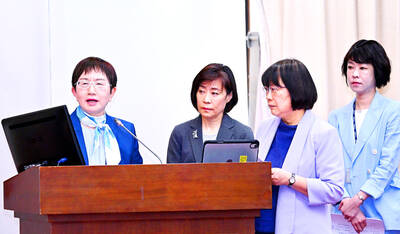New Taipei City was the most popular destination for relocation among the six special municipalities in the first half of this year, when 46,000 people moved to the city, Great Home Realty Co (大家房屋) said on Tuesday, citing government data.
A total of 659,000 people changed their address nationwide, and New Taipei City stood out as the top choice, compared with Taipei, Taoyuan, Taichung, Tainan and Kaohsiung, Great Home Realty head researcher Mandy Lang (郎美囡) said.
Lang attributed the trend to relatively affordable housing prices and better job opportunity outlook in New Taipei City.
Living in New Taipei City is cheaper than in Taipei, but it is similarly convenient in terms of public transportation and other infrastructure, Lang said.
Communiting to work in Taipei is feasible for residents of New Taipei City and Taoyuan, thanks to the MRT railway serving metropolitan Taipei, she said.
Lang said Tainan and Kaohsiung are expected to become the next trending destinations for relocation, as the two cities have attracted investment plans from major local tech firms.
Property funds have flowed to Tainan and Kaohsiung in the past few years and housing prices have picked up significantly, Lang said.
However, the majority of relocations took place within the same county or city, as people avoid drastic changes, she said.
H&B Realty Co (住商不動產) said relocation numbers might rise in the run-up to local elections in November, a trend seen ahead of past elections.
People must live in a certain district for at least four months before they can vote there, H&B head researcher Jessica Hsu (徐佳馨) said.
Otherwise, job and education concerns dominate relocation decisions, Hsu said.

‘SWASTICAR’: Tesla CEO Elon Musk’s close association with Donald Trump has prompted opponents to brand him a ‘Nazi’ and resulted in a dramatic drop in sales Demonstrators descended on Tesla Inc dealerships across the US, and in Europe and Canada on Saturday to protest company chief Elon Musk, who has amassed extraordinary power as a top adviser to US President Donald Trump. Waving signs with messages such as “Musk is stealing our money” and “Reclaim our country,” the protests largely took place peacefully following fiery episodes of vandalism on Tesla vehicles, dealerships and other facilities in recent weeks that US officials have denounced as terrorism. Hundreds rallied on Saturday outside the Tesla dealership in Manhattan. Some blasted Musk, the world’s richest man, while others demanded the shuttering of his

ADVERSARIES: The new list includes 11 entities in China and one in Taiwan, which is a local branch of Chinese cloud computing firm Inspur Group The US added dozens of entities to a trade blacklist on Tuesday, the US Department of Commerce said, in part to disrupt Beijing’s artificial intelligence (AI) and advanced computing capabilities. The action affects 80 entities from countries including China, the United Arab Emirates and Iran, with the commerce department citing their “activities contrary to US national security and foreign policy.” Those added to the “entity list” are restricted from obtaining US items and technologies without government authorization. “We will not allow adversaries to exploit American technology to bolster their own militaries and threaten American lives,” US Secretary of Commerce Howard Lutnick said. The entities

Minister of Finance Chuang Tsui-yun (莊翠雲) yesterday told lawmakers that she “would not speculate,” but a “response plan” has been prepared in case Taiwan is targeted by US President Donald Trump’s reciprocal tariffs, which are to be announced on Wednesday next week. The Trump administration, including US Secretary of the Treasury Scott Bessent, has said that much of the proposed reciprocal tariffs would focus on the 15 countries that have the highest trade surpluses with the US. Bessent has referred to those countries as the “dirty 15,” but has not named them. Last year, Taiwan’s US$73.9 billion trade surplus with the US

Prices of gasoline and diesel products at domestic gas stations are to fall NT$0.2 and NT$0.1 per liter respectively this week, even though international crude oil prices rose last week, CPC Corp, Taiwan (台灣中油) and Formosa Petrochemical Corp (台塑石化) said yesterday. International crude oil prices continued rising last week, as the US Energy Information Administration reported a larger-than-expected drop in US commercial crude oil inventories, CPC said in a statement. Based on the company’s floating oil price formula, the cost of crude oil rose 2.38 percent last week from a week earlier, it said. News that US President Donald Trump plans a “secondary